Sizing Up Servers: Intel's Skylake-SP Xeon versus AMD's EPYC 7000 - The Server CPU Battle of the Decade?
by Johan De Gelas & Ian Cutress on July 11, 2017 12:15 PM EST- Posted in
- CPUs
- AMD
- Intel
- Xeon
- Enterprise
- Skylake
- Zen
- Naples
- Skylake-SP
- EPYC
Intel Expanding the Chipset: 10 Gigabit Ethernet and QuickAssist Technology
The refresh strategy from Intel on the chipset side has an ultra-long cadence. In recent memory, Intel’s platform launches are designed to support two generations of processor release, and in that time there is typically no chipset update, leaving the platform controller hub semi-static for functionality for usually three years. This is compared to the consumer side, where new chipsets are launched with every new CPU generation, with bigger jumps coming every couple of years. For the new launch today, Intel pushing the enterprise chipset ahead in a new direction.
The point of the chipset previously was to provide some basic IO support in the form of SATA/SAS ports, some USB ports, and a few PCIe lanes for simple controllers like USB 3.0, Gigabit Ethernet, or perhaps an x4 PCIe slot for a non-accelerator type card. The new chipsets, part of the C620 family codenamed Lewisburg, are designed to assist with networking, cryptography, and act more like a PCIe switch with up to 20 PCIe 3.0 lane support.
The headline features that matter most is the upgrade in DMI connection to the chipset, upgraded from DMI 2.0 to DMI 3.0 to match the consumer platforms, having those 20 PCIe 3.0 lanes from the chipset, and also the new feature under CPU Uplink.
For the new generation of Lewisburg chipsets, if an OEM requires that a platform has access to a cryptography engine or 10 Gigabit Ethernet, then they can attach 8 or 16 lanes from the processor into the chipset via this CPU Uplink port. Depending on which model of chipset is being used, this can provide up to four 10 GbE ports with iWARP RDMA, or up to 100 GB/s IPSec/SSL of QuickAssist support.
Intel will offer seven different versions of the chipset, varying in 10G and QAT support, but also varying in TDP:
On the cryptography side, Intel has previously sold add-in PCIe cards for QuickAssist, but is now moving it onto the systems directly. By adding it into the chipset, it can be paired with the Ethernet traffic and done in-situ, and specifically Intel points to bulk cryptography (150 Gb/s AES256/SHA256), Public Key Encryption (100k ops of RSA2048) and compression (100+ Gb/s deflate).
With the GbE, Intel has designed this to be paired with the X722 PHY, and supports network virtualization, traffic shaping, and supports Intel’s Data Plane Development Kit for advanced packet forwarding.
The chipset will also include a new feature called Intel’s Innovation Engine, giving a small embedded core into the PCH which mirrors Intel’s Management Engine but is designed for system-builders and integrators. This allows specialist firmware to manage some of the capabilities of the system on top of Intel’s ME, and is essentially an Intel Quark x86 core with 1.4MB SRAM.
The chipsets are also designed to be supported between different CPUs within the same multi-processor system, or for a system to support multiple chipsets at once as needed.


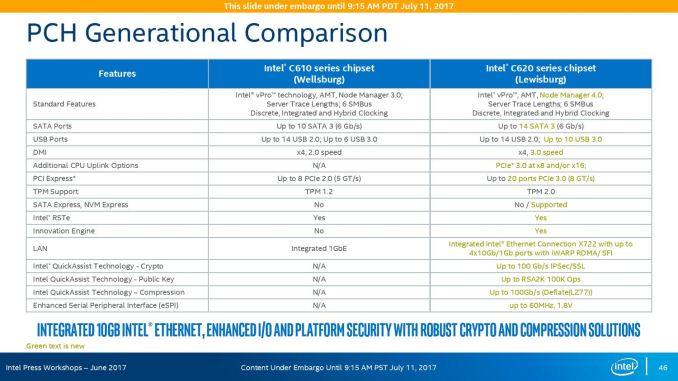
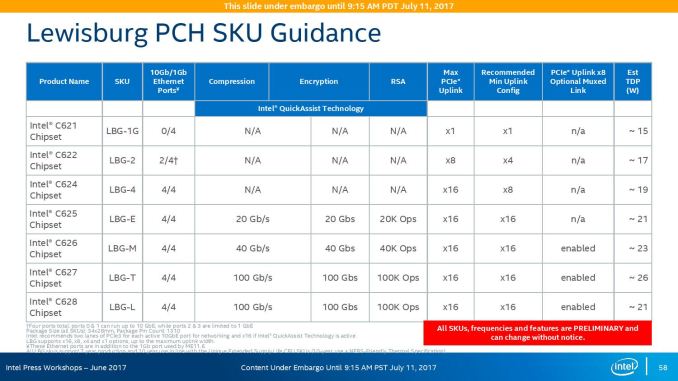
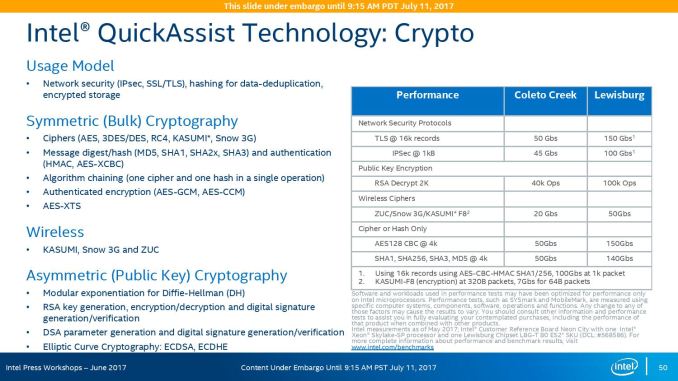

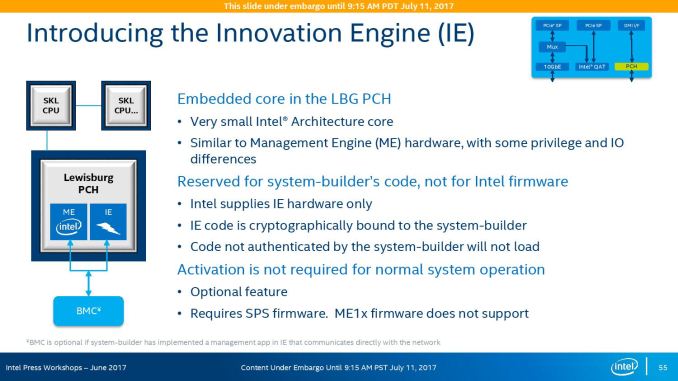
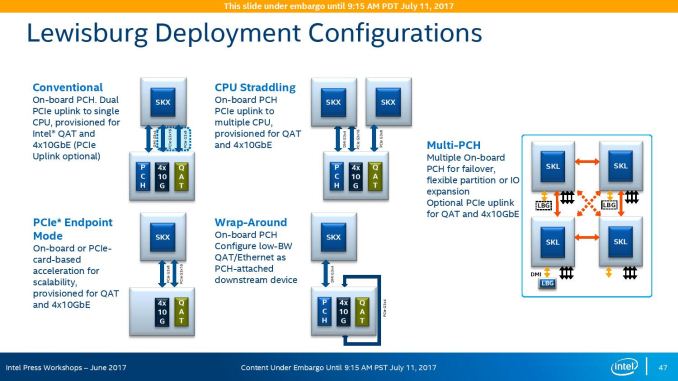








219 Comments
View All Comments
tamalero - Tuesday, July 11, 2017 - link
How is that different if AMD ran stuff that is extremely optimized for them?Friendly0Fire - Tuesday, July 11, 2017 - link
That's kinda the point? You want to benchmark the CPUs in optimal scenarios, since that's what you'd be looking at in practice. If one CPU's weakness is eliminated by using a more recent/tweaked compiler, then it's not a weakness.coder543 - Tuesday, July 11, 2017 - link
Rather, you want to test under practical scenarios. Very few people are going to be running 17.04 on production grade servers, they will run an LTS release, which in this case is 16.04.It would be good to have benchmarks from 17.04 as another point of comparison, but given how many things they didn't have time to do just using 16.04, I can understand why they didn't use 17.04.
Santoval - Wednesday, July 12, 2017 - link
A compromise can be found by upgrading Ubuntu 16.04's outdated kernel. Ubuntu LTS releases include support for rolling HWE Stacks, which is a simple meta package for installing newer kernels compiled, modified, tested and packaged by the Ubuntu Kernel Team, and installed directly from the official Ubuntu repositories (not via a Launchpad PPA). With HWE 16.04 LTS can install up to the kernel of 18.04 LTS.I also use 16.04 LTS + HWE (it just requires installing the linux-generic-hwe-16.04 package), which currently provides the 4.8 kernel. There is even a "beta" version of HWE (the same package plus an -edge at the end) for installing the 4.10 kernel (aka the kernel of 17.04) earlier, which will normally be released next month.
I just spotted various 4.10 kernel listings after checking in Synaptic, so they must have been added very recently. After that there are two more scheduled kernel upgrades, as is shown in the following link. Of course HWE upgrades solely the kernel, it does not upgrade any application or any of the user level parts to a more recent version of Ubuntu.
https://wiki.ubuntu.com/Kernel/RollingLTSEnablemen...
CajunArson - Tuesday, July 11, 2017 - link
Considering the similarities between RyZen and Haswell (that aren't coincidental at all) you are already seeing a highly optimized set of RyZen results.But I have no problem seeing RyZen be tested with the newest distros, the only difference being that even Ubuntu 16.04 already has most of the optimizations for RyZen baked in.
coder543 - Tuesday, July 11, 2017 - link
What similarities? They're extremely different architectures. I can't think of any obvious similarities. Between the CCX model, caches being totally different layouts, the infinity fabric, Intel having better AVX-256/512 stuff (IIRC), etc.I don't think 16.04 is naturally any more optimized for Ryzen than it is for Skylake-SP.
CajunArson - Tuesday, July 11, 2017 - link
Oh please, at the core level RyZen is a blatant copy-n-paste of Haswell with the only exception being they just omitted half the AVX hardware to make their lives easier.It's so obvious that if you followed any of the developer threads for people optimizing for RyZen they say to just use the Haswell compiler optimizations that actually work better than the official RyZen optimization flags.
ddriver - Tuesday, July 11, 2017 - link
Can't tell if this post is funny or sad.CajunArson - Tuesday, July 11, 2017 - link
It's neither: It's accurate.Don't believe me? Look at the differences in performance of the holy 1800X over multiple Linux distros ranging from pretty new (OpenSuse Tumbleweed) to pretty old (Fedora 23 from 2015): http://www.phoronix.com/scan.php?page=article&...
Nowhere near the variation that we see with Skylake X since Haswell was already a solved problem long before RyZen lauched.
coder543 - Tuesday, July 11, 2017 - link
Right, of course. Ryzen is a copy-and-paste of Haswell.Don't make me laugh.